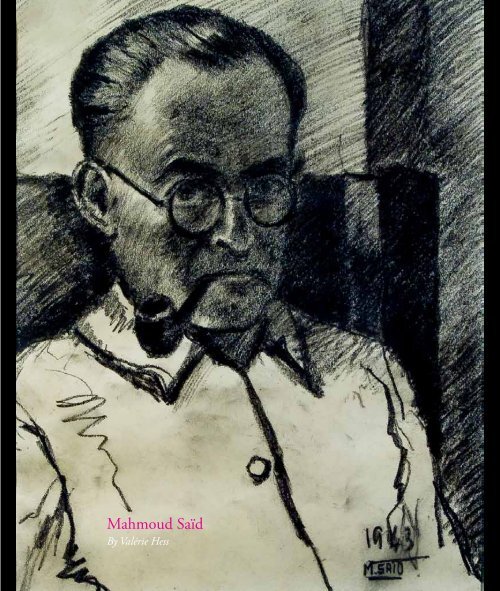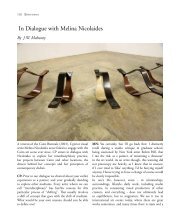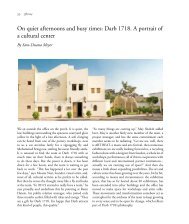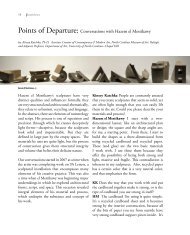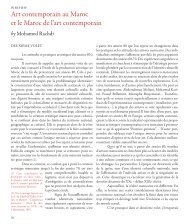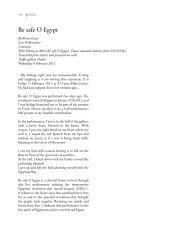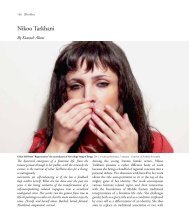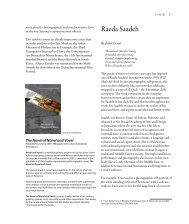full essay - Contemporary Practices
full essay - Contemporary Practices
full essay - Contemporary Practices
- No tags were found...
Create successful ePaper yourself
Turn your PDF publications into a flip-book with our unique Google optimized e-Paper software.
Essay77Mahmoud Saïd: Faithful Or Disloyal To Western Art?Historical and social backgroundIn order to study Mahmoud Saïd’s oeuvre, it is crucialto understand its historical, social and cultural setting.As mentioned briefly in the introduction, the notion of‘national identity’ was very recent as the chain of multiethnicinvasions raging through Egypt for more than2,000 years was only breached in 1922 when the countrydeclared its independence from British protectorate.The main consequences of this turbulent history areboth political and cultural. On one side is the people’sgrowing feeling of resistance against colonialism thatled to nationalism and ultimately independence; onthe other side, 2,400 years of history tainted by sucha variety of ethnicities meant the accumulation of anunparalleled rich cultural heritage, overwhelming thisnew nation. In contrast to Western Art, which emergedfrom the common notion of nationhood, ethnic artsdeveloped relatively independently from each other,being rooted in different races, cultures and nationalitiesfrom the Islamic diaspora. Hence the challenge forMahmoud Saïd and the other Modern Egyptian artistswas to reconcile the concept of nationalism, intrinsicallylinked to unity, with the disparity of their country’sopulent and abundant cultural baggage. As emphasisedby Liliane Karnouk in her critical study on ModernEgyptian Art, Egyptian artists needed to find `a balancebetween loyalty to an imposing past and their effort toliberate themselves from its burden’ .The sense of nationalism in Egypt already existed underMuhammad Ali’s (1769-1849) leadership, as he liberatedEgypt from the French, although it still remainedunder Ottoman sovereignty until the First World War.Ahmed Orabi (1841-1911) also sought to quench thisnationalistic thirst by forming a movement to go againstthe foreign ruling elites in Egypt. Yet nationalism inEgypt firmly established itself under British colonialismas the Egyptian politician Saad Zaghloul (1859-1927)led a nationalistic party, called the Wafd, against thiscolonial power, which culminated in three weeks ofblood-drenched protests in Cairo in March 1919. Atthe Paris Peace Conference in April 1919, Zaghlouland the Wafd asked for Egypt’s independence and itwas only three years later that Britain finally gave inand put an end to its protectorate in Egypt. All thesepolitical events were rapidly unfolding at the same timeas Mahmoud Saïd’s early beginnings as an artist.In conjunction with these historical incidents therewas an ‘Egyptian Awakening’ in the 19th and 20thcenturies, as labelled by Liliane Karnouk, with regardsto arts and culture. Karnouk describes all the elements ofthis ‘Egyptian Awakening’ in her chapter titled as such,starting from the Romantics who travelled to Egypt toseek the original beauty of Antiquity; the Orientalistswho sought a new visual vocabulary through their travelsin these exotic lands of the Middle East; Vivant Denon’s(1747-1825) publication of Description de L’Egypte in21 volumes pursuant to the Napoleonic 1798 expeditionto Egypt; Jean-François Champollion’s (1790-1832)deciphering of Egyptian hieroglyphs in 1822; theincreasing number of acquisitions of Egyptian artefactsby leading European museums and the excavation ofmany archaeological sites in Egypt, which climaxed inHoward Carter’s discovery of Tutanhkamun’s tomb in1922. Karnouk explains how the accumulation of thesehistorical and cultural events became the ingredientsthat nurtured a new Egyptian ideology referred to asNeo-pharaonism, popular in the 1920s and 1930s.Mahmoud Saïd’s counterpart in sculpture, MahmoudMokhtar (1891-1934), embodied this very notion ofNeo-pharaonism through his graceful and monumentalworks, the most iconic being the imposing sculptureat the entrance of Cairo University, entitled Egypt’sAwakening (1919-1928).It is this confrontation between a growing nationalismand an increasing awareness or ‘awakening’ of Egypt’spast that sourced the foundations of Modern EgyptianArt. Within this political and cultural context, theEgyptian artist had to create a ‘national’ style, and toachieve this, it was necessary to turn towards Western Art.Western Art had been introduced in Egypt over the pastcenturies with leaders hiring European artists to workfor them. Moreover, Orientalism, Romanticism andcolonialism brought waves of foreign artists who settledin Egypt. As described in Elizabeth Miller’s extensiveresearch, in the 1920s, Mahmoud Saïd’s native city,Alexandria, counted more than a fifth of the populationthat was foreign, including predominantly Greeks andItalians, but also British and French nationals . Even so,there were many Egyptians in Alexandria as in Cairo
Essay85Good Government in the City, 1338-40 (detail)(fresco), Lorenzetti, Ambrogio (1285-c.1348). Palazzo Pubblico, Siena, Italy. The Bridgeman Art Library.Saïd’s own versions of those subjects. The same artisticexchange seems to have occurred between some of Saïd’sworks and Angelopoulo’s female peasant portraits andGreek views, or Charles Boeglin’s landscapes. The closefriendship between Saïd and several foreign painters inEgypt seems clear when looking at the various portraitshe painted of them, such as that of Georges Khoury(1921), Aristomenis Angelopoulo (1934), CharlesBoeglin (1936) or Dimitri Litsas (1940).Saïd’s Interpretation of Western ArtAs per the above, Western influences throughoutSaïd’s œuvre are present in various ways, yet they arecomplex and eclectic. Art historians have discussed atlength how learning from Western Art was importantand necessary for the 20th century Egyptian artist as astepping-stone to form his own visual language. NadaShabout highlights this as she writes that ‘it was a meansof liberating themselves from a restrictive, stagnanttradition’ . This is, in many aspects, what MahmoudSaïd achieved and it is probably one of the reasons whyhe has been identified as one of the founding fathers ofModern Egyptian Art. The way in which Saïd employedWestern aesthetics and interpreted them with hisown style will therefore be discussed in the followingparagraphs, leaning on several specific examples of Saïd’sworks. Yet, Saïd’s first-hand encyclopaedic knowledgeof Western art through his travels and his relationshipwith many foreign artists did not impede him in usingeverything he learned, heard and observed, to serve hisown purpose. He clearly defined what he was searchingfor in his paintings when he wrote to Beppi-Martin in1927: ‘what I am looking for is radiance rather thanlight. What I want is internal light, not surface light, thatblazing and deep light of some of the Limoges enamelwork that can be found in the Cluny museum, or in thestain-glass windows of Chartres cathedral; or the onein Barcelona. Surface light pleases for a minute or anhour while internal light captivates slowly, but once itappears, it imprisons us, it possesses us’ . It appears fromthis extract that Saïd wanted to grasp the intangible.What he visited and admired throughout his Europeantravels, seems to have been one of the main catalyststhat paradoxically made him reach beyond Western
86 EssayMahmoud Saïd, Naïma, oil on canvas, 108x85cm., 1925. Sherwet Shafei Collection, Cairo. Courtesyof Safarkhan Gallery, Cairo.Art. Miller stresses that the key to understandingSaïd’s art is to bear in mind the notion of art havingan essence that transcends history and geography, hencethe development of something that goes beyond theaesthetics of Western Art. She summarises by statingthat ‘Saïd’s search was one for deeper meaning, meaningthat went beyond specific nationalities and historicalmoments to capture a deeper essence of mankind’ .In Ma femme au châle vert, painted in 1924, Saïddepicts his beautiful young wife, Samiha Hanem Riad,two years after their marriage. She sits grace<strong>full</strong>y undera sumptuous portico, paved with cream and brickcoloured,possibly marble, flagstones. She seems tobe caught off-guard, shyly yet graciously turning hereyes away from her husband as he painted her. Mrs.Mahmoud Saïd is unaware of the scene happeningbehind her, with a horse rider climbing up the hilltowards the village. The architectural setting hints toone of the masterpieces of Early Flemish painting thatSaïd may have seen in the Louvre Museum during histrips to Paris, La Vierge du chancelier Rolin or Vierged’Autun, painted circa 1435 by Jan van Eyck. The archesand the squared black and white pavement decoratingvan Eyck’s setting may have been in Saïd’s mind when
Essay89Berthe Morisot with a Bouquet of Violets, 1872 (oil on canvas), Manet,Édouard (1832-83). Musée d’Orsay, Paris, France. The Bridgeman ArtLibrary.records one of his many escapes in Lebanon from theheavy Egyptian summer heat. He depicts the spectacularmountainous view from Dhour El-Shoueir in thisperfectly balanced composition, combining his ownstyle with the theories of Italian and Northern EuropeanRenaissance works fused with early 20th century arttrends. Dhour El-Shoueir is a picturesque mountaintown, situated at an altitude of 1250 metres, just nextMahmoud Saïd, Ma Sœur (Zeinab Saïd), oil on board, 45x30cm., 1920.May Zeid & Adel Youssry Khedr Collection, Cairo.to the main Beirut-Damascus route and overlookingthe Lebanese capital as well as the Mediterranean Sea. Itwas, and still is, one of the most popular summer resortsof the Governorate Mount Lebanon, despite it havingbeen on the front line during the Civil War. The snapshotof the massive grey-white mountain in the background,the summit of which has been cut off by the canvasedges, gives it an even more dominant position in the
92 EssayMahmoud Saïd, Ma femme au châle vert, oil on board, 93x75cm., 1924.Mahmoud Saïd Museum, Alexandria.their own artistic inheritance, offering them a modernmodel of nonrepresentational art by means of whichthey might reconcile their present and past’ . Similarlyto those artists categorized by Shabout, Mahmoud Saïdfused and re-interpreted Western visual vocabulary withwhat he observed around him and with what he revivedfrom Egypt’s past. According to Shabout, this is whatleads an artist like Saïd to fall under the umbrella of‘Modern Egyptian Art’. This is particularly noticeablein his depictions of Egyptian scenes. These signaturepaintings are intrinsically Egyptian in the way in whichthey engage in dialogue with Saïd’s fellow ModernEgyptian artists and seem to pay tribute to Egypt’spast and present. Moreover, his approach to EgyptianThe Rolin Madonna (La Vierge au Chancelier Rolin), c.1435 (oil onpanel), Eyck, Jan van (c.1390-1441). Louvre, Paris, France. The BridgemanArt Library.subject matters enables him to extract an authentic‘Egyptian-ness’ from them in his manner of incarnatingcore nationalist and even contemporary feministideologies, and of embracing tradition and spiritualityin his paintings. Saïd’s cousin and art critic AhmedRassem best described this unique character in theartist’s oeuvre, claiming that his ‘painting is Egyptian inthe most precise meaning one can give to the word. HeSaïd is not like those poets who think they can createoriental work by putting Pyramids and the Bedouininto their verses’ .When looking through lavishly illustrated bookstreating the subject of Modern Egyptian Art, there is nodirect visual evidence of stylistic consistency amongst all
Essay93the artists listed under that category. Nonetheless, a fewexamples in Mahmoud Saïd’s oeuvre prove the existenceof a rich artistic exchange between the painter and hisEgyptian contemporaries. The most obvious appears tobe between him and the other recognized pioneer ofModern Egyptian Art, the Cairene sculptor MahmoudMokhtar. The latter’s oeuvre is very much imprintedby the Egyptian ideology of Neo-Pharaonism in hissubject matter and in the very medium he employed -sculpture. Whether Mokhtar intentionally provoked orpromoted this ‘re-awakening’ of Egypt’s cultural past isdebatable, yet he used it as a means to affirm his ownartistic and national identity. Another reading of hisoeuvre is suggested by Mahmoud Saïd in the very poeticand sentimental letter he wrote in Arabic followingMokhtar’s premature death in 1934. According to thisdocument, Saïd seemed to understand Mokhtar’s artas an expression of the ‘population’s sacrifice for thesake of modernization’ . Saïd praised his friend for thestimulating role he had in the artistic realm of his time,writing that Mokhtar ‘had come in a moment when ourhearts were beating strong and looking into the future’. He perhaps also insinuated Mokhtar’s leading exampleof creating a national Egyptian art, concurrentlyflourishing within Egypt’s politics.Following this deep homage to Mokhtar the year of hisdeath, it is not entirely unexpected to find that Saïd’smasterpiece of Les chadoufs was painted that year, 1934.This work is one of the most deeply rooted in Egyptiansoil, with its predominant earthy colours soaked in awarm Egyptian sunlight. It depicts the hard labour ofthe peasants drawing the water through the ‘chadoufs’to irrigate agricultural land, replicating what theirancestors had been doing for centuries to obtain a richfertile soil. The triangular composition of Les chadoufs,reminiscent of Renaissance perspective, is echoed by theworkers’ loincloths and by the setting’s topology, verypossibly hinting to Egypt’s proud pyramids. The femalefigure in the lower right corner, carrying an amphora onher head, seems to quote Mokhtar’s woman unveilingthe Sphinx in his monumental sculpture Egypt’sAwakening. Focusing on these various elements, Leschadoufs could arguably be described as being oneof Saïd’s most ‘Neo-Pharaonist’ masterpieces, as atribute to his deceased friend. The art of other ModernEgyptian Artists appears to have interacted with Saïd’soeuvre. Mohammed Naghi, a painter also based inAlexandria yet from a different social background, waspart of the same artistic environment. He also studiedart in Europe and obtained a degree in law, yet hisfather pushed him to become an Egyptian diplomat.At the end of the First World War, Naghi visited oneof the pioneers of Impressionism, Claude Monet(1840-1926), in his legendary premises of Giverny.This visual and cultural encounter had an impact onNaghi’s art, as seen in the present work illustrated,exemplifying an interpretation of Monet’s ‘pleinair’method of painting Saïd’s legal and artistic careerdeveloped alongside Naghi’s diplomatic and painter’scareer, bringing them close together within Egypt’sartistic circle. Saïd’s painting El Norag most probablydates from his early years as a painter, revealing his briefencounter with Impressionism. Two care<strong>full</strong>y drawnpreparatory sketches for this painting have survivedand are very academic in their execution, unveiling hisrecent training years in France. The visual similaritiesin terms of subject matter and painterly execution,stylistically leaning towards Impressionism and Post-Impressionism, between El Norag and Naghi’s paintingare undeniable. They show how both started paintingin the same direction and how their social backgroundsand respective careers would later lead them to go onseparate artistic paths. Despite their differences, Naghidefinitively recognized Mahmoud Saïd as a crucialcontributor to the creation of a national identity inModern Egyptian Art. Indeed Naghi depicted Saïd, aswell as Mokhtar, alongside himself and other criticalEgyptian and foreign historical, political and culturalfigures, in his most famous artwork entitled The Schoolof Alexandria (1935-1959), which was unfortunatelyburned in 2011. Mahmoud Saïd was therefore an activeparticipant in the artistic development of his country andthere are other numerous examples of visual dialoguesbetween him and other Modern Egyptian artists suchas Salah Taher, Georges Sabbagh, and Ragheb Ayad.Yet the most ‘Egyptian’ influence in Saïd’s art findsits root in what the painter observed around him. Hepainted more than fifty paintings representing Egyptianlandscapes, out of which more than twenty include theNile. In addition, there are approximately more than
94 EssayMahmoud Saïd, L’inauguration de l’ouverture du canal de Suez, oil on canvas laid down on board, 223x400cm., 1946-7. Mahmoud Saïd Museum,Alexandria (on loan from the Museum of Modern Art, Cairo).twenty portraits that feature what appears to be the NileRiver in their backgrounds. One of Saïd’s masterpieces,heavily charged with Egyptian culture, history andgeography, is Le Nil vers Béni Hassan, painted in 1951. Fan palm trees stand stoically along the west coast ofthe Nile, opposite the archaeological necropolis of BéniHassan on the East, as the sail boats travel from Northto South in the direction towards Abydos, a well-knownancient cult site for Osiris, god of the afterlife and thedead in Ancient Egypt. Béni Hassan was an AncientEgyptian cemetery situated in the area between Assiutand Memphis. It was predominantly used during theMiddle Kingdom (21st-17thC BC) for the burial ofprovincial governors in decorated rock-cut tombs.In Le Nil vers Béni Hassan, he includes one of hisbeloved motifs, the quintessentially Egyptian vesselscalled feluccas, peace<strong>full</strong>y floating on the Nile withtheir abstract triangular sails. Saïd subtly plays with themirroring effects of the water, delicately blending in thereflections of each element from his composition withthe bright beige tones from the Béni Hassan necropolispouring into the Nile, as well as the blue, brown andwhite touches from the felucca in the foreground,which all underline the calmness and almost stillnessof Said’s painted scene. Yet his endless rigidity withhis composition’s lines is strengthened by the verticalscreated by the feluccas’ sails and the palm trees’ trunks,and by the curved diagonals from the Béni Hassan rocks,replicating the movement emerging from the felucca’sbulging sail. All these compositional lines converge atthe top of the sailboat’s mast in the foreground, creatinga peaceful balance within the composition, yet at thesame time, breathing in a mystical dynamism to thisscene on the Nile, very characteristic of Mahmoud Saïd’s
Essay95Credit The Pilgrims Meet Pope Cyriac before the Walls of Rome, from the St. Ursula Cycle, 1498 (oil on canvas),Carpaccio, Vittore (c.1460-1523). Galleria dell’ Accademia, Venice, Italy Alinari. The Bridgeman Art Library.pictorial structure. The bright firm light submergingLe Nil vers Béni Hassan possibly echoes the awakenednational Egyptian pride. At the same time, the paintingresonates much of Egypt’s glorious past throughthe location of the scene next to the tombs of BéniHassan, but also through its depiction of the Nile, oneof the most important and vital elements of Egyptiancivilization. To a certain extent, the boats sailing on theNile could also be connotations of Ancient Egyptianreligious burial rituals. The feluccas may symbolicallyrefer to the Egyptian God Ra’s boat, which carried thegood souls of the deceased to the heavenly shores wherethey were ensured immortality by being offered anafter-life. Said’s feluccas are hence a tribute to Egyptianheritage, possibly hinting to some of the scenes lavishlydecorating the Béni Hassan tombs and depicting theAncient Egyptian belief of the quest for the afterlife.Incarnation of Nationalism & FeminismWhen the newly founded group ‘La Chimère’ held itsfirst show in 1927, works of its European and Egyptianmembers, such as Mokhtar, Saïd, Ayad and Naghi, wereexhibited. There were ladies of high society attendingthe event, who were ‘outspoken feminists involved inthe struggle for the emancipation of women initiatedby Hoda Shaarawi’ . Parallel to the growing feeling ofnationalism, Hoda Shaarawi (1879-1947) was a leadingfigure in the history of feminism in Egypt. She was avery accomplished educated woman. She organisedlectures for women and opened a school in 1910 forgirls, teaching them academic studies with the aimof breaching the tradition of women being confinedto the house or the harem. She shocked Egyptians bypermanently removing the hijab after her husband’sdeath in 1922. Furthermore, she was a prominent figure
98 EssayMahmoud Saïd, Les chadoufs, oil on panel, 89x117cm., 1934. Private collection. Christie’s Images Ltd., 2010.and beauty – the girl herself seems to be clutching onto these attributes as she grips her right arm with herleft hand. The social and political context in whichthis beautiful portrait was painted opens the doorto further interpretations with regards to what thisyoung ‘fellaha’ stands for. Whether she refers to Egypt’sgrowing notions of feminism or nationalism, it seemsthat she will never yield to modernisation. Through hispainting of La Petite Fille d’Assiout, Saïd has ‘frozen’this image of the Assiut girl that incarnates traditionalEgyptian youth.In Femme aux gargoulettes (1930), hedepicts a traditional scene of a female servant carryingtwo heavy water jugs on a tray. As opposed to the morecustomary image of the woman carrying the jug on hershoulder or on her head, as seen in some of Mokhtar’sand Saïd’s works, the painter here decides to depict heras a seemingly strong woman, effortlessly bringing outthe water jugs on the window’s ledge. He has idealisedhis model as her body and facial features do not showany visible sign of hard work or constraint. On thecontrary, he used his signature warm pigments so thather skin has a glistening gold colour. He employed avibrant yellow-ochre colour for her face and her chest,illuminating her in a supernatural and almost mysticalway as she emerges from the dark background inside theroom. Her almond-shaped eyes, her deep red lusciouslips and her breasts almost glowing in the shadow makeher an embodiment of female temptation. This aspect ishighlighted by her plunging cleavage and by her vest’sstraps sliding down her shoulders. Whether a simple
100 EssayMohammed Naghi, Paysage (Vache dans le pré), 40x50cm., oil on board, circa 1920. Dr. Hussam Rashwan Collection, Alexandria.study as well as a smaller painting in 1928. All threedepict dervishes from the Mawlawi order performingtheir own version of the ‘zikr’, the Islamic devotional actduring which God is remembered through the repeatedrecitation of His Names. The Mawlawi dervishes’custom of the ‘zikr’ consists in a form of dance andmusical ceremony known as the ‘Sama’, which waspractised in the ritual hall called the ‘samahane’. Thedervishes usually spin on their left foot and wear a flaredand loose white gown, as a symbol of death; a wideblack cloak known as the ‘hirka’, standing for the grave;and a conical felt brown hat named ‘kûlah’ or ‘sikke’,that symbolises the tombstone. The Mawlawi dervishesbelieved that by performing the ‘Sama’, their spiritualascent through the mind and love would enable themto reach the ‘Perfect’. It is precisely this mystical journeyof the human spirit that he illustrates in these threepaintings. What strikes the viewer when first looking atthose works is the extraordinary virtuosity in replicatingthe swirling movement of the dervishes onto a twodimensional surface. The helical composition is dictatedby the dervishes’ care<strong>full</strong>y thought out positions,balanced by the direction of their opened arms and oftheir tall hats. Saïd appears to have experimented withtwo different ways of achieving the spinning effect of thedervishes’ dance. The three dervishes are very differentlystaged when comparing the watercolour with the smaller1928 panel. In the former, he tried out the compositionon a vertical format and placed the dervishes very closeto one another, to form a tight group at the centreof their rotational dance. The dervish wearing a lightred cloak in the foreground is the spin’s driving force,with his arms opened wide, almost like a propeller. Incontrast, the horizontal option for the 1928 panel offers
Essay101Mahmoud Saïd, El Norag, oil on canvasboard, 25.4x36cm., circa 1920. Courtesy Meem Gallery, Dubai.more room for the three dervishes to spread out intothe pictorial space. Unlike the watercolour, there is nosingle nucleus for the revolving dynamics in the panel.Each of the three dervishes has their own individualrotational axis, emphasised by the folds in their widewhite gowns. A fourth virtual axis at the centre of thecomposition, behind the figure in the foreground, seemsto further stress the overall swirling effect, bringing allthree figures together in a harmonious composition.The Les derviches tourneurs dated 1929 combines theexperiments from both the watercolour and the smallerpanel into a larger complex composition. The settingis the ‘samahane’ and its circular structure emphasisesthe dervishes’ dance. Again the propeller-like arms ofthe dervish are used as seen on the right. He opted for avertical format, hence for a tight composition, as he hadtried out in the watercolour. However, he also focusedon the reflection of light on the dervishes’ white gownsto highlight their folds and their whirling effect, hencepreserving the different axis of each dervish that rotatearound the central figure, as tested out in the smalleroil panel. The ‘chiaroscuro’ technique epitomized inRembrandt’s (1606-1669) and Caravaggio’s (1571-1610) oeuvres seems to have been an element of WesternArt that Saïd borrowed and adapted to his own use andstyle. As mentioned previously, light played a vital rolein his oeuvre and he used it here as a means to amplifythe mystical nature of the dervishes’ ‘Sama’, likewise toRembrandt’s way of depicting a divine apparition in hisfamous work entitled Belshazzar’s Feast (circa 1636-8;National Gallery of Art, London), hence capturing theessence of this traditional religious rite that has survivedsince the Ottoman Empire.The Islamic devotional act of the ‘zikr’ itself features asthe core of another monumental composition paintedin 1936, for which he also produced a very complete
102 EssayMahmoud Saïd, Le Nil vers Béni Hassan, oil on canvas, 80.5x100cm., 1951. Dr. Hussam Rashwan Collection, Alexandria.preparatory work the same year. When comparing thelatter with the final painting, it becomes obvious thatlight was an essential element in his oeuvre and evenmore so for these spiritual subject matters, enabling himto express the ritual’s holiness. The ‘zikr’ oil sketch issuperbly built up with impressionistic and spontaneousyet meticulous brushstrokes of thick impasto. The brightpigments and the repetition of white highlighted in themen’s caps culminate in the central figure, wearing awhite gown, to create an overall vibrant composition.Saïd painted a preparatory work most probably to castand stage his characters in the pictorial space, beforetransposing them onto a larger canvas. There are severaltypes of ‘zikr’ that can be performed in private or public,yet the one represented in both works seems to be themost common group ceremony known as ‘hadra’, thatusually takes place in a public space as suggested by thehouses in the background. ‘Zikr’ is best translated fromArabic into English as ‘remembrance’ or ‘invocation’.It is associated with liturgical readings, prayers, songand Qu’ranic recitals as a means to remember God.Musically, the celebrants recite repetitively on the sametone the Names of God whilst a soloist performs aseparate song on top. In his paintings, he portrayed the
Essay103Mahmoud Saïd, Petite Fille d’Assiout, oil on canvas, 78x62cm., 1945. Private collection. Christie’s ImagesLtd., 2011.participants caught in the act of repeating their prayers.The repetition sounds like a percussion instrument,the rhythm of which is punctuated by their bodymovements of bending forward to exhale and standingup straight to inhale. While the oil sketch transcribedthe musical repetition of the ‘zikr’ into the recurrenceof white, blue and brown pigments and the alignmentof figures squeezed against one another, in the finalpainting the initial composition was significantlysimplified by reducing the number of participants andby focusing on their facial features and body language.Each figure seems to be absorbed in their prayers, intheir own space, yet they are unified in their devotionalact through the incandescent light flooding the scene.The sculptural aspect of each character, highlightedby a gold shimmering light, contributes to the overallmonumentality and spirituality of the ‘zikr’, plungingthe viewer into the transcending realm of divinity.
104 EssayMahmoud Saïd, Les derviches tourneurs, oil on panel, 97.5x69.8cm.,1929. Private collection. Christie’s Image Ltd., 2010.An Artist Torn Between Two WorldsSocio-political tensions: Nationalism versusCosmopolitanismAs discussed in the previous paragraphs, MahmoudSaïd was a cosmopolitan artist who was influencedin some areas by a wide range of Western artisticcanons. At the same time, he was part of a generationduring which Egyptian nationalism reached its peak.Alongside of this, he sought to extract the essence ofEgyptian culture and history through his paintings. ItMahmoud Saïd, Les derviches tourneurs (esquisse),watercolour and brushand India ink on paper, 16.5x10cm., circa 1928-9. Dr. Hussam RashwanCollection, Alexandria.was his own way of preserving this traditional nationalheritage as modernisation crept into Egypt at a rapidpace. Saïd may have been caught in the middle of allthose pivotal changes, as his paintings sometimes revealsocio-political, cultural and psychological tensions.Miller pointed out that ‘the particularity of Saïd’spainting lies in the marriage of cosmopolitanism andnationalism’ . These two ideologies often confronteach other in his oeuvre in different ways, yet are mostvisible through his sitters’ fashion or the setting of the
Essay105Mahmoud Saïd, Les derviches tourneurs (esquisse), oil on panel, 39x67cm., 1928. Ms. Hala Halbouni Collection, Alexandria.scene. On an art historical level, we have seen earlieron through various examples how he harmoniouslyblends Pharaonic art with Renaissance perspective inthe same painting, or the subtlety of aerial perspectivewith Egypt’s fiery colours. Yet Saïd takes this clashof Western and Egyptian cultures to another levelthrough the disparity of fashion throughout his oeuvre.Depending on whether his sitter is a peasant girl or alady of high society, the clothes and attributes changeaccordingly in most cases. For example, the girl inFillette du Mariout of 1948 is portrayed with a simplewhite peasant’s dress and a dark veil, whilst the Portraitde Madame Mamdouh Riad, dated 1938. depicts herseated on a European-style ‘bergère’, wearing a lavishblack fur cloak, a Westernised dress and fancy jewellery.Although the social background has apparently dictatedfashion in each work, there are a few examples ofpaintings in which the social distinctions have beenblurred. Clothes are sometimes displaced and are notcoherent with the social background of the modelwearing them. This fusion of different social ranks mayreflect his own situation: coming from an aristocraticbackground, he was encouraged to have a judge’s careeras opposed to becoming an artist, a profession thatwas traditionally frowned upon by the high society atthe time. Saïd’s many portraits of family members orfriends, sharing the same background as him, confrontthe painter’s numerous fleshy nudes or his depictionsof street girls, ‘fellahas’ or dancers. These seeminglyincompatible types of subject matter discretely unveilthe artist’s social tensions and are sometimes mergedinto a single painting.Femme devant le Nil, painted in 1936, is one exampleillustrating the artist’s inner social conflict. An elegantwoman with bright red sensuous lips, dressed in aWestern-style blue dress, stands proudly with her armsfirmly crossed over one another in front of the Nile.Although Saïd painted an exquisite background forhis sitter, with his signature feluccas sailing smoothlyacross the river and the delicate layers of the water’stransparencies, the woman seems unaware of thebusy life behind her as she stares directly at the viewer
Essay107Mahmoud Saïd, El Zikr (esquisse), oil on board, 32.5x40cm., 1936. Nabil Nahas Collection, Beirut. Courtesy Agial Gallery, Beirut.Female nude paintings cover a relatively important part several times for Angelopoulo and Ezzat Ibrahim, mostof Saïd’s work. Working from private live nude models probably in the Greek painter’s studio. After Saïd’s death,was confined to his friends’ studios. This originally she was hired first as a model for the Faculty of Fineacademic training would have been impossible in his Arts of Alexandria, and later as a ‘Dada’ or servant forown house and an embarrassment in his aristocratic that same institution. This unpublished documentationmilieu. However, several unique photographs of those on Hamida provides a rare insight into Saïd’s socialfemale models have survived from artist Ezzat Ibrahim’s background and into his work environment as an artist.archives. Most of them have not yet been identified, The contrast between the model coming from the slumsalthough according to the artist Ismail Abdallah and and the artist painting her, who had been brought upto the sculptor Professor Gaber Hegazy, one of them in Alexandrian high society, was a means to connectportrays a girl called Hamida. Dr. Gaber Hegazy was with the people of his native land and to understandthe artist who made a cast of Saïd’s face and hand when more thoroughly their fascinating culture. It seemshe died, which are exhibited in the Mahmoud Saïd that Saïd sometimes dressed up his female models withMuseum. Hamida was paid 1/4 Egyptian pound per Western sophisticated clothes, as depicted in Nabouiahour and lived in El-Dhahriya, a slum in Alexandria. à l’imprimé (1952) and in La Fillette en rose (1945) .She was known for her voluptuous lips and she posed Both works seem to have been inspired by the models in
108 Essaycaptivating dark eyes and the bronze-like skin standingout against their pale-coloured dresses. Both Nabouiaand the Fillette en rose look away from the painter andviewer, as they gaze out of the painting towards theright in the former and towards the left in the latter.They seem disconnected from their surroundings andeven more so from the costume they are wearing.Saïd may have purposely chosen these Western ladylikedisguises to prove that his sitters’ ethnicity andnational identity prevail over modernisation. These twopaintings explored the bi-polarity of nationalism versuscosmopolitanism and expressed the social tensionshe encountered as an artist. Badr El Din Abou Ghaziclearly summarised Saïd’s social duality, writing that‘Opulence and sensuality – such as the dominants inthe painting of Said. He is the great Oriental lord, theman who paints for the joy of his exhilarated senses,who calls upon all the reminiscences of a refined culturewithout disdaining the humble daily spectacle offeringitself to us in the spontaneity of moods or folklorictruth’ .Mahmoud Saïd, Portrait de Madame Mamdouh Riad, oil on panel,104x73cm., 1938. Mahmoud Saïd Museum, Alexandria..two photographs, who most likely came from the samelower-class background as Hamida. The two paintingsportray a young, dark-skinned, Egyptian womanwearing a flowery dress and vest in Nabouia à l’imprimé,and a sober pink Westernised dress in La Fillette enrose. He also dressed them up with earrings, necklaces,bracelets and elaborate headdresses, merging street girlswith upper class ladies. Yet, in both works, emphasishas been on their Egyptian features, preserving thoseCultural Tensions: Traditions versus ModernismThere appears to be a common thread amongst most ofthe Mahmoud Saïd’s paintings discussed in this article.Whether they can be described as being nationalistic,cosmopolitan, spiritual or sensual, they all incarnatethe artist’s complex feelings towards tradition andmodernism. This profoundly sentimental aspect in hisworks is very much in line with Symbolist poetry andart. Symbolism was a late 19th century literary andartistic movement that developed in France, Belgiumand Russia. It revived the mystical tendencies ofRomanticism and believed that art should not representlife in a realistic or naturalistic way, but rather to ‘clothethe Ideal in a perceptible form’, as stated by the criticJean Moréas in the Symbolist Manifesto he publishedin September 1886. Symbolist painters resorted tomythology and dream imagery, yet their works did notalways have a precise literary reference. Their visuallanguage is much more personal, introvert, obscureand ambiguous, close to his own pictorial vocabulary.The writers and poets which he defined as the oneshe read most to Jean Moscatelli in his 1936 interview,were associated with Symbolism: Fiodor Dostoïevsky
Essay109(1821-1881), Marcel Proust (1871-1922) and CharlesBaudelaire (1821-1867) . In a later interview with Dr.Moustafa Soueif, he again admitted being influencedby Dostoïevsky and Baudelaire . What attracted Saïdthe most in Symbolism was its members’ individualcreations of personal myths, in which they sought tofind the ‘Ideal’. He composed his own Egyptian mythswhere the ‘Ideal’ corresponded to his commemorationof a better past, in resistance to modernism. Saïd is partof those ‘Arab peoples’, described by Nada Shabout of‘having been living somewhere between the past and thefuture but not in the present’, and of only ‘rememberingthe glories of their past golden age or dreaming about abetter and happier future’ . Despite this feeling of regretfor Egypt’s glorious days, he nonetheless producedsome very ‘modern’ paintings, an example of which isLe Dancing of 1934. In this work, the electric light, oneof the symbols of modernity praised by the Futuristsin the early 20th century, stands out, shining abovethe dancers and flooding the dance floor. The dancingcouples seem to be dressed in modern Western fashionand their posture, moves and steps are also reminiscentof Western ballroom dancing. These two paintings arevery different to their Egyptian folkloric counterparts,which depicted belly-dancers, La danseuse (1936) andDanseuse au takht (1949). The Dancing paintings of1934 embody modernism, whilst the two belly-dancersrefer to the Orient’s cultural heritage and traditionalcustoms. However, as mentioned earlier on, thesepaintings are rarely so black and white and so easilyrecognizable through their settings, as he confrontsmodernism with tradition in his own made-up imagery.The subject matters are sometimes difficult to defineand almost impossible to locate in time. His sitters oftenhave an ambiguous physical appearance and his cleverjumbles of social, cultural and artistic references resultin strikingly unusual compositions. Like the Symbolists,he created his own personal myth through which hestrived to grasp his own definition of the ‘Ideal’. Twoof his most incongruous paintings, Femme aux bouclesd’or (1933) and Invitation au voyage (1932) havedrawn academic attention because of their ambivalentsubject matters. In both masterpieces, his subconsciouscrossroad between modernism and tradition is evident.A determined time, place and identity does not exist inMahmoud Saïd, Fillette du Mariout, oil on canvas, 78x57cm., 1948.Sherwet Shafei Collection, Cairo. Courtesy of Safarkhan Gallery, Cairo.the inner crossroad, as it consists of displacements andjuxtapositions of different times, places and identitiesthat eliminate any ephemeral element. Hence in Femmeaux boucles d’or, Saïd intentionally confuses the viewerwith the mixed features of his bizarre sitter. RamsisYounan described her as a ‘creature’ that ‘is not a womanbut a satanic being borrowing a human mask, expressinga confused thought, an enigmatic idea embodied bynecessity in this material world’ . Elizabeth Millerunderlines the fusion of Arab, African and Europeantraits present in the woman’s face . Her thick red lipsseductively smiling, her almost too perfect golden locks
110 EssayMahmoud Saïd, Femme devant le Nile, oil on canvas, 80x55cm., 1936. Dr.Hussam Rashwan Collection, Alexandria.framing her face and her strangely raised eyebrowsbring her on the verge of caricature. At the same time,her robust body and polished gold skin invade mostof the pictorial space, as if the artist had blown out ofproportion a traditional Renaissance portrait imbuedwith own imagination. This fantasy female ‘creature’is like an indelible apparition, whose monumentalityand highly finished sculptural aspect make her standout as an indestructible statue of which, accordingto Miller, ‘the visual result walks a fine line betweenkitsch and a powerful and monumental expression ofhuman mysticism’ . Femme aux boucles d’or is the fruitof resistance to the rapid political, social and culturalchanges unfolding around him and stands for his refugeof what can be described as a ‘pre-modern temporality’.Invitation au voyage can also be read along the same
112 EssayMahmoud Saïd, Le Dancing, oil on board, 70.5x57cm., 1934. Mahmoud Saïd Museum, Alexandria.Psychological Tensions: Artist Versus LawyerBesides resisting the whirlwind of modernization andattempting to reconcile his social background withthat of some of his sitters, Saïd was also faced withpsychological tensions on a daily basis. As per his family’sexpectations, he pursued a lawyer’s career, yet, as provedthrough his prolific oeuvre, he was an avid painter. It wasonly in 1947, at the age of fifty, shortly before his father’sdeath, that he resigned from his position to dedicatehimself to painting. Throughout his artistic career hemanaged to bring together on canvas his professionalouter world, that of the courtroom where he worked,and his inner passion for art by painting portraits ofhis colleagues. Portrait du Président: Jaspar Brinton isa very detailed and academic work that was paintedin 1945 (53). Brinton (1878-1973) was an Americanlawyer and judge who was appointed as an Americanrepresentative at Egypt’s Mixed Courts (54). At the time
Essay113Mahmoud Saïd, Femme aux boucles d’or, oil on canvas, 80x60cm., 1933.May Zeid & Adel Youssry Khedr Collection, Cairo.Saïd realized his portrait, Brinton was the president ofthe Court, from 1943 to 1948, before becoming a legaladvisor to the American Embassy in Egypt until 1953.As early as 1930, Jasper Yeates Brinton already describedhis fellow judge Mahmoud Saïd as ‘Egypt’s leadingpainter’ in the book he published on The Mixed Courtsin Egypt . Although the people he worked with seem tohave discerned his talent not only as a lawyer but also asan artist, it seems to have been much more challengingto gain similar recognition from his own family. LilianeKarnouk recalls the interview she had with ex-QueenFarida, Mahmoud Saïd’s niece, on 22nd October1983, in which she remembered how her relatives wereindifferent to her uncle’s art and how this lack of moralMahmoud Saïd, Portrait de Jasper Brinton, oil on panel, 108.5x84.5cm.,1944.support affected him. Being a <strong>full</strong>-time artist was not aprestigious profession at the time and not somethingSaïd’s family would have been proud of. Karnouk quotesthe former Queen’s most revealing passage expressingher relatives’ attitude, ‘Besides they could not relateto his art. The closest they came to showing a sign ofapproval was when they acknowledged that it must begood because foreigners seemed to appreciate it’ .Saïd’s struggle to come to terms with a disapprovingfamily and with his daily function as a judge permeatesparticularly throughout his self-portraits. He depictshimself in six known paintings, possibly twice in 1919,once circa 1920, and again in 1924, 1929 and 1931.Two charcoal sketches of circa 1930 and another of
114 Essay1943 have also been identified as self-portraits. In hisfirst known self-portrait, dated 1919, he is in his studioin Ramleh, wearing a painter’s blouse and holding hispalette and paintbrushes, most likely sitting in front ofhis easel. He makes a firm statement in this work thatalthough he has recently graduated from Law Schooland his family predestined him to become a judge, heis also a young 22-year old painter, eager to study artfurther. The year after he completed this self-portrait heembarked on his visits to the private artistic academiesin Paris and on his European tour.In his undated self-portrait here illustrated, the artistappears to be roughly of a similar age as in the Ramlehone dated 1919. This striking self-portrait is an unusualexample in the history of art as the artist here omittedany reference to his profession as a painter and there areno attributes to locate this portrait, unlike the Ramlehself-portrait. The artist’s focus was exclusively on his ownfacial features, and more precisely on the dramatic andalmost cinematographic lighting employed to heightenhis expression and to share his deepest feelings withthe viewer, or at least to lash them out onto the canvas.There are very few examples of other painters depictingthemselves in such a personal manner, as traditionallythe artist is dressed in a particular way, working in hisstudio or the background of the self-portrait offersinformation on its location or its meaning. One ofthese uncommon examples is Paul Cézanne’s selfportraitof circa 1862-1864. It contains similar lightingand a tenebrous background like Saïd’s, yet it is muchmore restrained in terms of the artist unleashing hisemotions. When Saïd stripped his head bare of anyvisual reference and even of his own body in this selfportrait,he strived to capture the tormenting feelingsoverwhelming him. Saïd’s long career struggle and hisendless social conflict overshadow this work. He alsotransmits these heavy tensions through his paintbrushand colour tones in this self-portrait. For example, thethick impasto around the eyes and in places on hisface, and the agitated brushstrokes used for his whiteshirt and tie, directly translate the artist’s psychologicaltorment. The liveliness and tangibility of these tornemotions are further enhanced by the white ochre tonescontrasting with the dark pigments, which illuminatehis face and make it emerge from a deep backgroundof darkness. Saïd here again masters the chiaroscurotechnique, yet takes it a step further using it as a meansto heighten his expression and pour out his frustration,almost transforming his self-portrait into a scene froma dramatic movie.This turbulent portrait is very different from his lastrecorded self-representation dated 1943, where hedepicts himself as a much more settled artist, relaxingwhilst smoking a pipe. The elaborated hatching andshading achieved through his charcoal medium iscare<strong>full</strong>y balanced so as to obtain a dramatic light,making it a very lively portrait of the artist. Once again,concentrating all the tension on his face, through hisfeatures and expression, the portrait reduces his bodyto a few spontaneous thick dark outlines. The apparentcontrast in terms of emotions and physical appearancebetween the undated oil self-portrait and this charcoalsketch offer a rare insight on his personal evolution,from being a young ambitious man torn between twoopposing careers to becoming a praised artist whosucceeded in reconciling his two aspirations and whowould soon choose his passion over his legal career. BadrEl Din Abou Ghazi best described Saïd’s tumultuouslife and the way he dealt with various social, culturaland personal tensions, writing that ‘if the life of Saïdmay have appeared peaceful on the surface, his innerlife was torn between the values of his society and hispersonal desires, between limitations laid upon him bycircumstances and his aspirations to freedom and selffulfillment.He is one of those artists who were destinedto integrate two conflicting vocations and ways’ .
Essay115ConculsionIn a review of the 1938 Cairo Salon, where severalworks by Mahmoud Saïd were exhibited, a criticwriting in the newspaper Al Risala observed that ‘thefundamentals of life are the same in all times and places.Environment and era are two factors without which artwould not be complete, but the essence of art is one inany time or place… It is clear that Mr. Mahmoud BeySaïd is the most excellent of all those exhibiting theirwork [at the Salon] and the one with the most depthof poetry and of feeling’ . By 1938, Mahmoud Saïdwas a very established and accomplished artist, havingrealised one of his most challenging and monumentalcompositions the year before, La ville, that nowwelcomes the visitor in the Museum of Modern Art,Cairo. The critic detected the intrinsic uniqueness ofSaïd’s art, recognising its extraordinary ‘depth of poetryand feeling’. Al Risala writer also identified the coreof the Alexandrian artist’s paintings when he talkedabout the notion of ‘the essence of art’, omnipresentthroughout Saïd’s oeuvre, referred to several times inthis article. This complex transcending quality thatalways infused his works may also be an explanationfor the difficulty of ‘labelling’ the painter’s style andhence of finding him a place within the history of art.Although he falls under the roof of Modern EgyptianArt, his works are so rich in the variety of subject matterand diverse in terms of style and inspirations, that hecannot fall under one ‘-ism’. Paintings can be qualifiedby many contradictory artistic trends, as proventhrough the several examples referred to in the previouspages. His works are simultaneously Classical andModern, Academic and Pharaonic, Impressionist andExpressionist, Egyptian and Cosmopolitan, Realist andSurrealist, Naturalist and Symbolist. Yet this apparentheterogeneity in his oeuvre is always incorporatedinto beautiful harmonious compositions, often rootedin Egypt’s rich ancient cultural heritage. They form aunity that surpasses the eye and define national andartistic identity. From that point of view, one couldargue that the most relevant ‘label’ for his oeuvre, if itexisted, would be ‘transcendism’. This appears to be theidea behind Gabriel Boctor’s extract in which he wrotethat ‘Mahmoud Saïd has reinvented an Egypt that isgolden-skinned, sensual, and sumptuous; a thinkingEgypt with its pensive sheikhs; above all a delectable,appealing Egypt with its peasants, its streetwise girls,its little donkeys, all looking for the Happy Isle’ . All ofthe characters in his paintings look for that somethingthat surpasses them, the ‘Happy Isle’, in this imaginaryworld is the lost glorious past of Egypt’s golden age,before it was metamorphosed by modernisation.The multi-faceted aspect amd seemingly incoherentstyle, tortured by various tensions, is precisely the reasonwhy his oeuvre is so unique, but also so difficult tounderstand as a whole within the art historical context.The complication comes from the fact that he arrivedon the artistic Egyptian scene following a long ‘artisticvacuum’ in his native country. Paradoxically, at the sametime, the West found inspiration in the East, as arguedby Tony Maraini that ‘while Modern art was born in theWest, it is not uniquely Western’ . There are numerousexamples of Eastern influences, and more particularlyIslamic art, on Modern European Art, such as HenriMatisse’s arabesque-style pieces (Matisse even admittedthat ‘inspiration always came to me from the East’), oras seen in the art of Pablo Picasso, Paul Klee and theNabis painters . Art history is a continuous thread ofdialogues between cultures and artistic styles and, untilMahmoud Saïd’s arrival on the scene, that dialogue wasonly one-way. He, along with his sculptural counterpartMahmoud Mokhtar, re-initiated the interrupted visualcommunication and laid the foundations for the arthistorical dialogue that Egypt’s future generationspursued throughout the 20th century and continue topursue today. Although Saïd, like Mokhtar, Ayad andNaghi, was one of Egypt’s ‘re-awakened’ artists from theso-called ‘First Generation’, he also played the role of‘awakener’ for all these younger artists who continuedto develop the concept of Modern Egyptian Art. Thelack of stylistic and aesthetic consistency within ModernEgyptian Art, yet embedded in a common culturalheritage, is exactly what defines it, as summarized byNada Shabout claiming that ‘the nature of “modernArab art”: [it] is not a unified organized movementbut rather a plurality of styles and experiences, the sumtotal of creative individual experiments from variousArab countries’ . Saïd showed how art could be usedas the vehicle for the expression of those ‘creativeindividual experiments’ and deep emotions. Through
Essay117Mokhtar’s death, 1934 (translated from Arabic).Letter written by Mahmoud Saïd following MahmoudMokhtar’s death, 1934 (translated from Arabic).Karnouk, ibid., p. 10.Karnouk, ibid., p. 14.Karnouk, ibid., p. 14.Miller, ibid., p. 74.Miller, ibid., p. 222.Please note that in E. Dawastashy’s book (1997), Baigneusesis referenced as no. 117 p. 179 and is titled Nu-la FellahaÉgyptienne.Miller, ibid., p. 211.Miller, ibid., p. 228..B. El Din Abou Ghazi & G. Boctor, Mahmoud Saïd, Cairo,1952, p. 15 (translated from Arabic in Karnouk, ibid., p. 22-23).M.Saïd, in an interview with J.Moscatelli, 1936, ibid.Dawastashy, ibid., p. 164.Shabout, ibid., pp. 42-3.R. Younan, quoted in A. Rassem, ibid. (in Karnouk, ibid., p.23).Miller, ibid., p. 214.Miller, ibid., p. 214.Miller, ibid., p. 233.Miller, ibid., p. 225.Ex-Queen Farida, personal interview with L. Karnouk,October 22, 1983 (in Karnouk, ibid., p. 21).Abou Ghazi & Boctor, ibid., p. 2 (translated from Arabic inKarnouk, ibid., p. 21).N. Atallah Susa, Al Risala, v. 6, 1, 9 May 1938, p. 787), inMiller, ibid., p. 209.G. Boctor, Artistes contemporains d’Égypte, Mahmoud Saïd,Cairo, 1952, p. 14 (translated from French in M. Abaza (withcollector’s notes by Sherwet Shafei), Twentieth-Century EgyptianArt: The Private Collection of Sherwet Shafei, Cairo, 2011, p.13).Shabout, ibid., p. 43.Shabout, ibid., p. 45.Shabout, ibid., p. 43.Quoted in M. Abaza, ibid., p. 37.


